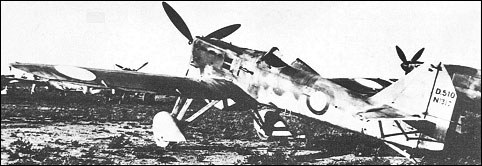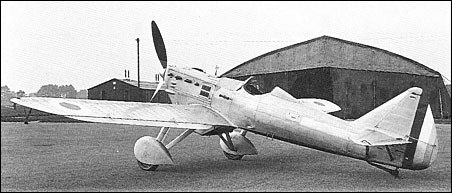|
| Two of the 15 D 500 series aircraft (the second and
tenth) comprising the initial production contract for the
new low-wing fighter monoplane placed with SAF-Avions
Dewoitine were fitted with the Hispano-Suiza
12Ycrs (HS 77) engine as prototypes for the D 510.
Heavier and longer than the HS 12Xcrs (HS 76) of the
standard D 501 fighter, the HS 12Ycrs similarly catered
for a 20mm cannon between its cylinder banks, and
was rated at 775hp at sea level and 860hp at 4000m. The first of the D 510 prototypes flew (without
the cannon fitted) on 14 August 1934, the second
(with cannon) following on 10 December. Apart from
engine, the D 510 was fundamentally similar to the D
501, the cannon being complemented by a pair of
7.5mm wing guns. In May 1935, the Ministere de l'Air
placed an initial contract for 35 (later reduced to 25) D
510s, these being delivered from 9 October 1936. Seven
more D 510s were then built for the Armee de l'Air as
agreed replacements for a similar number of D 501s
taken from the service's deliveries as part of the Lithuanian
order. Follow-on contracts then called for a total of
80 more aircraft from which a contract for 24 D 510s
from the Chinese Central Government was to be fulfilled.
Other export D 510s were single examples to the
UK and the Soviet Union, and two to Japan for evaluation
purposes, and two, unofficially, to Republican
Spain. These last had been the first two of a cancelled
contract for Turkey and were ostensibly sold to the
Hedjaz (Saudi Arabia). When it was revealed that the
two D 510s had arrived in Spain, the French government
insisted that their engines be returned to France.
Eventually, both aircraft were fitted with M-100
(licence-built HS 12Ybrs) engines from a Tupolev SB
bomber and allegedly saw some combat. Three Groupes de Chasse were still flying with the D 510 at
the beginning of World War II, but re-equipped during
the first months of the conflict. Two Escadrilles Regionale
de Chasse in North Africa converted to D 510s in
September-October 1939, flying them until mid-1940,
and two escadrilles of the Aeronautique Navale formed
on D 510s in December 1939 and May 1940.
| WEIGHTS |
| Take-off weight | 1929 kg | 4253 lb |
| Empty weight | 1496 kg | 3298 lb |
| DIMENSIONS |
| Wingspan | 12.09 m | 40 ft 8 in |
| Length | 7.94 m | 26 ft 1 in |
| Height | 2.42 m | 8 ft 11 in |
| Wing area | 16.50 m2 | 177.60 sq ft |
| PERFORMANCE |
| Max. speed | 402 km/h | 250 mph |
| Range | 700 km | 435 miles |
 | A three-view drawing of The standard production Dewoitine D 510 (800 x 502) |
| GrahamClayton, e-mail, 29.12.2024 10:37 The last Dewoitine D510s to be used were with GC I /6 at Dakar, Senegal in 1941, being replaced by Curtiss H-75s. reply | | Army Dicked, 19.12.2014 22:00 The dewoitine D510 was one of my favourite French Aircract of WW2. Although too old to fight in the ETO, they did serve in china against the Japanese. It's a stunning, beautiful mid 1930s air craft. I recall reading they had problems with the 20mm cannon, an early Hispano-Suza. It would jam if you shot it while Diving. The Rifled 7.7mm MGs would do modest damage to unprotected Japanese aircraft and would occasionally bounce off German aircraft. You have to forgive the French---the Socialists did everything they could to throttle the French Govnt to defend France. worse, was the explosive growth in air technology from 1934-1944 where bleeding edge aircraft became useless junk days into manufacture?!? reply |
| zudum, e-mail, 13.02.2011 03:02 parece um bom modelo,gosto muito dos aviões da Dewoitine
pena que os trem de pousos não eram retráteis reply |
|
Do you have any comments?
|
| 
COMPANY
PROFILE
All the World's Rotorcraft
|









A more sober view of France in the period of the Third Republic would be of benefit, if we are to assess where responsibility for the poor state of French armaments lay by March 1939 (when the Germans violated the Munich Agreement by occupying the remainder of the Czech State).
The failures were systemic and complete. The extremism of French political discourse allowed the same set of amoral political figures to run the French Government during the critical Inter-War years, and this poison of mediocrity at its heart killed France--not merely the desire for French workers to have a week-end or over-time pay, nor the Industrialists desire for modern factories and a stable banking system.
The French--right, left, and especially centre, seem to have chosen the worst possible course of action at every single turn, and they paid for it with a stunning national defeat that led to national humiliation and the degradation of a once venerated hero.
reply